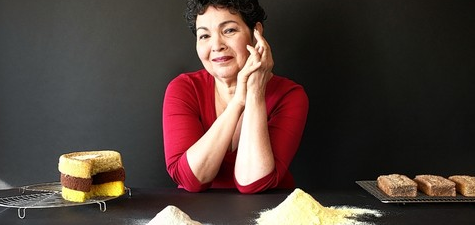
The problem with buying a sack of teff or buckwheat or chestnut flour is that you have to find recipes in which to use them. If you buy a large bag – that is a lot to get through – especially if you are used to reaching for the All-Purpose bag of flour.
When Super Chef was sent a bag of Farina di Castagne or organic chestnut flour from Chestnut Hill Nursery and Orchards along with a bag of Fiocchi di Castagne or chestnut flakes, we turned to an expert.
Alice Medrich‘s Flavor Flours (Artisan 2014) of course! The subtitle is: A New Way to Bake with Teff, Buckwheat, Sorghum, Other Whole & Ancient Grains, Nuts & Non-Wheat Flours. This isn’t baking 101 for non-gluten eaters – it is for anyone who wants to explore the wonderful world of alternates to wheat.
 Of course, the results are gluten-free, but the approach is the important part. She is not creating gluten-free flour mixes to use instead of wheat. These are recipes that explore specific flavors in each flour. We are all familiar with oats eaten as oatmeal or cookies. She found that baking with oat flour produced butterscotch notes:
Of course, the results are gluten-free, but the approach is the important part. She is not creating gluten-free flour mixes to use instead of wheat. These are recipes that explore specific flavors in each flour. We are all familiar with oats eaten as oatmeal or cookies. She found that baking with oat flour produced butterscotch notes:
Chestnuts are most familiar as a wintertime treat, roasted and sold on street corners, or used in traditional turkey stuffing. The flour produced from dried chestnuts is soft and sweet, a wonderful and inspiring baking ingredient. (p. 12)
Alice writes extensively on what makes baking with these different flours easy and challenging – for instance, cakes do not “dome” so they are easier to decorate, but you have to be careful to hydrate them enough – but not too much. She encourages bakers to first experiment with pancakes, waffles, and crepes – exchanging wheat flour for any of the flours she writes about. There are recipes for each using any kind of flour with extra rice flour (pp. 23-24). There is a helpful chart of suggestions for add-ins, including Ricotta cheese and fresh figs with a drizzle of honey for chestnut flour pancakes.
But what about that chestnut flour? She includes an entire chapter on chestnut flour.
Chestnut flour gives cakes a very soft crumb that is never gritty and has plenty of flavors. It can be used alone, without any other flour, and works wonderful in all kinds of sponge and egg-based cakes, meringues, and even a simple honey pudding. (p. 198)
Alice’s first recipe is for Chestnut Sponge Cake with Pear Butter and Crème Fraiche (p. 200) would be wonderful as a special finish to a winter dinner party. Keep Chestnut Buche De Noel (pp. 202-4) as the masterpiece to end Christmas dinner. Admire the photograph of a Buche by Leigh Beisch (p. 205) complete with the meringue mushrooms and sugared leaves. But you could also make the Ricotta Cheesecake with Chestnut Crust (p. 215) if you happened have made ricotta for those morning chestnut pancakes, or Quince and Orange-Filled Chestnut Cookies (p. 223) which should encourage Americans to plant more quince trees!
Flavor Flours is the cookbook to turn to if you want to explore the baking aisle beyond wheat. The recipes are smart, easy to follow, and inventive. You may decide to get this book so you can cook for gluten-free friends – but you will end up using it to cook for everyone.
